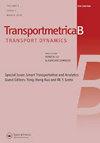多控制下混合车辆的异质交通流的稳定性和通行能力
IF 3.4
2区 工程技术
Q2 TRANSPORTATION
引用次数: 10
摘要
本文章由计算机程序翻译,如有差异,请以英文原文为准。
Stability and capacity for heterogeneous traffic flow mixed with vehicles in multiple controls
Cooperative adaptive cruise control (CACC) is regarded as a promising approach to improve traffic stability and capacity by operating vehicle-to-vehicle (V2V) communication. However, the beneficial effect of CACC vehicles is greatly reduced due to the influence of manually driven vehicles (MDVs) in the heterogeneous traffic flow, in which the degradation of CACC vehicles is a considerable problem. One proposed solution is to install communication devices for MDVs, called IMDVs, to propagate information to CACC vehicles and prevent the degradation. This study analyzed the traffic flow configuration by introducing IMDVs and considering multiple traffic flow operations, e.g. vehicle degradation and platoon formation. Then, multiple factors, including market penetration rate, platoon length, and information flow topology, were taken into consideration in the theoretical modelling of linear stability and fundamental diagram. Finally, we verified the high accuracy of theoretical analysis by numerical experiments and gave some reasonable recommendations for traffic management.
求助全文
通过发布文献求助,成功后即可免费获取论文全文。
去求助
来源期刊

Transportmetrica B-Transport Dynamics
TRANSPORTATION SCIENCE & TECHNOLOGY-
CiteScore
5.00
自引率
21.40%
发文量
53
期刊介绍:
Transportmetrica B is an international journal that aims to bring together contributions of advanced research in understanding and practical experience in handling the dynamic aspects of transport systems and behavior, and hence the sub-title is set as “Transport Dynamics”.
Transport dynamics can be considered from various scales and scopes ranging from dynamics in traffic flow, travel behavior (e.g. learning process), logistics, transport policy, to traffic control. Thus, the journal welcomes research papers that address transport dynamics from a broad perspective, ranging from theoretical studies to empirical analysis of transport systems or behavior based on actual data.
The scope of Transportmetrica B includes, but is not limited to, the following: dynamic traffic assignment, dynamic transit assignment, dynamic activity-based modeling, applications of system dynamics in transport planning, logistics planning and optimization, traffic flow analysis, dynamic programming in transport modeling and optimization, traffic control, land-use and transport dynamics, day-to-day learning process (model and behavioral studies), time-series analysis of transport data and demand, traffic emission modeling, time-dependent transport policy analysis, transportation network reliability and vulnerability, simulation of traffic system and travel behavior, longitudinal analysis of traveler behavior, etc.
 求助内容:
求助内容: 应助结果提醒方式:
应助结果提醒方式:


